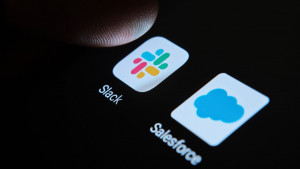- Adam Mansfield
- Reading Time: 3 minutes

Salesforce acquired Slack back in July of 2021 with the goal of helping customers become more connected, more productive, and more innovative in a digital-first world. The over $900M messaging app platform was purchased by Salesforce for nearly $28B.
Since completing the acquisition, Slack continues to drive impressive numbers and exceed Salesforce’s guidance expectations. In FY22 Q3, the number of customers paying $100,000 or more for Slack went up 44% and they did $280M in revenue, $30M ahead of guidance.
Because Slack is proving to drive growth post-acquisition, you can expect Salesforce to push Slack on its customers moving forward. But what exactly will this push look like and how can customers prepare and leverage the conversations Salesforce will inevitably start around Slack? I’ll discuss Salesforce’s Slack strategy and what customers need to know to make the most of this acquisition.
What is Salesforce’s Strategy for Slack in 2022?
It is clear that Salesforce is leveraging its Slack-First solutions, including Slack-First Customer 360, Slack-First Sales, and Slack-First Service, to make every Salesforce product more powerful and more effective for their customers. In fact, Salesforce Co-CEO Bret Taylor has said that Slack comes up in every single one of his customer conversations.
The big takeaway from Taylor’s comments is that this is the direction Salesforce is going in – they will be heavily pitching these Slack-First solutions. Working with a lot of enterprises already, I’m seeing this play out, and I’m getting the calls from CIOs and line-of-business executives asking me what to make of the Slack-First transition. Enterprise customers want to understand the power behind this shift.
Here’s what’s happening: There is going to be a spike in the asks for conversations on Salesforce’s end. We’re already seeing it and you have probably already experienced it. This will especially be the case for customers who haven’t made investments in Slack already or for customers who have Salesforce and Slack and are thinking about the integration of the two. Either way, these conversations are going to be a focus moving forward.
Because of this, there is an important question to keep in mind moving into 2022 – how is Salesforce going to measure Slack success? Taylor mentioned previously that, beyond Salesforce customers getting the value from Slack, these measures of success are going to show up in areas like multi-cloud deals that include Slack.
Because of this, we know that one of the KPIs for sales is going to be ensuring that, in some capacity, Slack is included in all renewals. This will most likely be through Slack Connect, which enables enterprises to share messaging channels with teams in other companies. This strategy will especially be important as Salesforce tries to figure out the Slack-First Sales and Slack-First Analytics solutions and how they go to market.
How Can Enterprise Customers Leverage These Conversations Around Slack?
Since integrating Slack into all renewal deals will be a key strategy moving forward, it is important for you to leverage that at the negotiation table. Obviously, if you are already using Slack Connect as a customer, you want to use and position that effectively because you know this is what Salesforce needs and wants.
You should also be aware that Salesforce may start to push the combination of Slack and Tableau, which was also acquired by Salesforce in 2019. If you are considering Tableau or have not used Tableau, expect selling around both the Slack and Tableau product offerings. If you’re already a Slack customer, expect Salesforce to emphasize that Slack makes Tableau easier to use and more efficient and, therefore, could allow you to unlock more value. It’s no longer just about Customer 360 – it’s about Slack-First Customer 360.
Another interesting point to keep in mind regarding Slack is that Gavin Patterson, Salesforce’s Chief Revenue Officer, has stated that when Salesforce is closing deals, they’re leaning into closing deals on Slack itself. They’re creating channels between Salesforce and the customer on Slack and ensuring that everyone who is working on the deal has access through that channel. According to Patterson, this has allowed deals to close more quickly.
If you’re a Salesforce customer and you have a renewal coming up, you should expect this approach and be mindful of what Salesforce is doing. You need to make sure your procurement, sourcing, and vendor management people are on top of this as well.
Access to individuals in the channel is powerful for Salesforce. Thus, while having unified communication was always important, it now becomes even more important. If there are only certain people in the Slack channel and they control that room, that’s going to affect the final deal, so you need to be thinking about this in terms of renewal and negotiation preparation. Slack gives Salesforce another way to take control of the negotiation process that could be detrimental if not countered and if not approached appropriately.
The Bottom Line
Salesforce will be driving their Slack-First solutions as we move through 2022, so it is critical you know how to approach your negotiations and renewals to maximize the value you receive. You should push Salesforce to focus on the actual additional value your organization will realize from their Slack-First solutions. Make these solutions and Salesforce’s desire to push them work for your goals, not against them.
Comment below, follow me Adam Mansfield on Twitter @Adam_Mansfield_, find my other UpperEdge blogs and follow UpperEdge on Twitter and LinkedIn.
Related Blogs
Salesforce Increasing Pricing and Adding Agentforce Options: What Customers Need to Know Now
Salesforce’s New Agentforce Pricing: What Customers Should Know
Salesforce Product Changes: What You Need to Know and How to Navigate Them
About the Author
